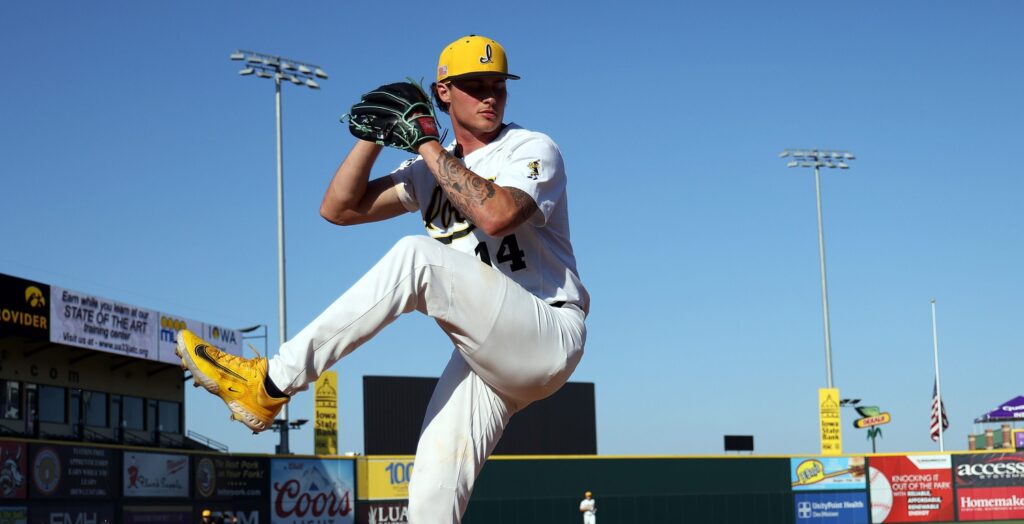What possible reason for hope could any Colorado Rockies fan have for the future?
It’s more than a fair question. It’s the right one.
After a second-consecutive 100-loss campaign, still somehow mired in the unrelenting and everlasting aftermath of the Nolan Arenado fiasco, and drowning in the weight of unprecedented fan and media apathy, how can one even begin to utter the word hope?
This team had one starting pitcher, just one, who managed to be barely above the park-and-league adjusted average ERA+ and it was Ryan Feltner at 102.
Collectively they had a league-worst ERA of 5.48 and ERA+ of 84. Those are among the worst marks in a franchise history filled with frightful pitching.
And you can’t win if you don’t pitch.
So I will ask the question one more time and with a bit more context; Why should anyone, regardless of the potential of their young position players, have any hope for the future of this team?
The answer is actually four answers: Chase Dollander, Brody Brecht, Sean Sullivan, and Carson Palmquist.
There have been times in their past when the Rockies have had strong farm systems that eventually led to a modicum of success in MLB. The most recent occurrence featured now iconic names like Nolan Arenado and Charlie Blackmon but also, and arguably more importantly, a slew of strong pitchers in German Marquez, Kyle Freeland, and Jon Gray among others.
As during that time, the Rockies have a deeper well of potential starters than just the top names. And a few of those top names didn’t exactly pan out in Colorado including Tyler Anderson, who was able to find himself elsewhere, and Eddie Butler, who was not.
So it would be both inaccurate and unfair to place the entirety of the future on the shoulders of these four players, especially because there is more depth beyond them.
Jordy Vargas and Gabrielle Hughes, for example, both have high pedigree but have been off the radar for a few years after Tommy John surgery. Jack Mahoney, Connor Staine, Mason Albright and others have also shown a lot of promise.
But this fearsome foursome have both as much talent as any group of pitchers the Rox have ever had on the farm and are also close to beginning to make their impact.
Palmquist is the closest, though also maybe the longest shot to make it. A big lefty with a 5-pitch mix featuring an above-average slider and change-up, Palmquist had regularly topped 11 K/9 while keeping the BB/9 under 4.00 until reaching Triple-A when he began to offer a few more free passes.
He only spent 35.1 innings in Albuquerque so he likely needs a bit more seasoning but if he shows up to Spring Training attacking the strike zone he could earn himself a spot out of the gate.
Next is Brody Brecht who was taken by the club with the 38th overall pick in the most recent draft and is already considered the second-best arm in the system.
He brings grades of 70 on the 20-80 scouting scale for both his fastball and slider. He has yet to pitch professionally but at age 22 and a big 6’4 235 lb. frame, plus athleticism that also allowed him to play wide receiver at Iowa, you have a good candidate to rise quickly through the minors.
His fastball/slider combo has even been compared to Paul Skenes (I promise I’m not making that up) with his heat able to touch 101 MPH.
Meanwhile, Sean Sullivan represents the other side of the spectrum. He doesn’t have the same flashy top-end tools but rather a lot of really good ones. He uses an unusual arm angle, excellent control, and late movement to keep getting fantastic results.
In 2024, the 6’4 lefty pitched 115.1 innings across High-A and Double-A, striking out 125 batters and walking an almost-impossible-to-believe 15. In his minor league career, he has tallied 135 strikeouts and just 16 walks.
That kind of reluctance to give up anything for free and ability to keep runners off the bases is exactly the kind of formula that has, in some cases quietly, managed to tame Coors Field.
With only 32 innings at Double-A (with a 1.17 ERA) he will at least need the better part of a year at Triple-A before making his MLB debut but if he can keep putting up these kinds of numbers, he is going to fast-track himself.
Finally, the Rockies top-rated prospect pitcher, and second highest-rated prospect overall after Charlie Condon, is fireballer Chase Dollander who has already been better than advertised. And he was advertised as the best pitcher in the 2023 draft class.
Dollander’s first year as a pro couldn’t have gone much better as he jumped straight to High-A where he dominated enough over 70 innings to earn his promotion to Hartford. The jump in league didn’t phase him one bit and he would ultimately cruise to a 2.59 ERA over 118 innings pitched, striking out nearly 13 (12.89) batters per nine while keeping the walks at 3.58.
Like with Sullivan, he needs to keep it going into the highest levels of the minors and is set to have an extremely important Spring Training.
This level of talent can make a huge difference. It has before.
All that said, it isn’t reasonable to expect these guys to immediately change the team for the better. Each needs to be given the space to grow in their own time and reach the best versions of themselves.
But if they manage that, quite a few people will once again be surprised when the lowly Colorado Rockies start looking not so lowly with another group of homegrown pitchers.
Those who say it’s impossible either lack imagination or don’t know their history.
